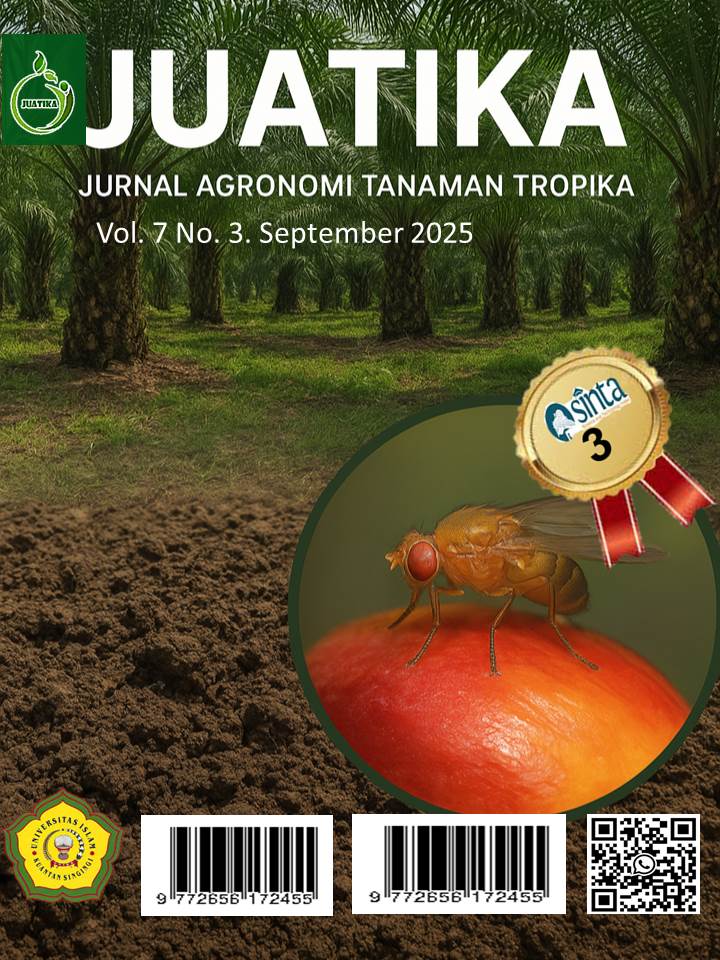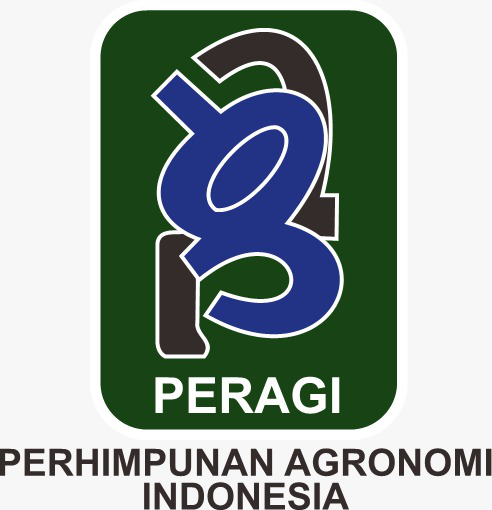Improving Oil Palm (Elaeis guineensis Jacq) Farmer Productivity in Labusona Village, Labuhan Batu Regency
Abstract
Oil palm (Elaeis guineensis Jacq.) is a plantation crop that plays a vital role in the Indonesian economy. This study aims to analyze production costs, income, and the effect of production costs on oil palm farming income in Lobusona Village, Labuhanbatu Regency. The research sample consisted of 30 farmers selected through simple random sampling. Data were analyzed using multiple linear regression. The results show that the average production cost incurred by farmers was IDR 60,600,167 per year, while the average revenue reached IDR 136,266,783 per year. This yield resulted in a net income of IDR 75,666,617 per year, or approximately IDR 24,532,139 per hectare per year. The F-test results indicate that production costs, when considered simultaneously, have a significant effect on income (Sig. 0.000 < 0.05). Meanwhile, the t-test results reveal that fertilizer costs had no significant effect, whereas pesticide and labor costs had a significant adverse effect on income. Conversely, annual production, plant age, and the price of fresh fruit bunches (FFB) had a significant positive effect. The coefficient of determination (R²) of 0.996 demonstrates that 99.6% of the variation in income is explained by the variables included in the model. These findings suggest that the efficient allocation of production costs—particularly for pesticides and labor—is crucial for improving the profitability of oil palm farming.
Downloads
References
Daniel, W., Sidharta, J., & Simanjuntak, R. P. (2024). Penerapan metode target costing dalam mengendalikan biaya produksi untuk meningkatkan laba (Studi kasus: UMKM Ghanior Indonesia). Buletin Ekonomi, 24(2), 68–91.
Fahrudin, A. (2018). Analisis pendapatan dan faktor-faktor yang mempengaruhi produksi usaha budidaya tambak ikan. Efficient: Indonesian Journal of Development Economics, 1(1), 77–85.
Fauzi, Y., Widyastuti, Y. E., Satyawibawa, I., & Paeru, R. H. (2012). Kelapa sawit. Penebar Swadaya Grup.
Hance, N., Herdhiansyah, D., & Syukri Sadimantara, M. (2022). Analisis pengolahan kelapa sawit pada PT XYZ di Kabupaten Morowali Utara (Analysis of palm oil processing at PT XYZ in North Morowali Regency). Jurnal Teknologi dan Manajemen Industri Pertanian, 3, 202–209.
Ikatan Akuntan Indonesia. (2019). Standar akuntansi keuangan. Salemba Empat.
Mustika, S., Marhawati, M., & Damayanti, L. (2021). Analisis pendapatan usahatani kelapa sawit di Desa Lalundu Kecamatan Rio Pakava Kabupaten Donggala. Agrotekbis: Jurnal Ilmu Pertanian (e-Journal), 9(5), 1270–1275.
Nengsih, Y. (2016). Tumpangsari tanaman kelapa sawit (Elaeis guineensis Jacq.) dengan tanaman karet (Hevea brasiliensis L.). Jurnal Media Pertanian, 1(2), 69–77.
Pamungkas, D. A., & Siregar, S. (2021). Analisis faktor-faktor yang mempengaruhi pendapatan petani karet di Desa Hayup Kecamatan Haruai Kabupaten Tabalong. JIEP: Jurnal Ilmu Ekonomi dan Pembangunan, 4(1), 180–196.
Pardamean, M. (2018). Panduan lengkap pengelolaan kebun dan pabrik kelapa sawit. AgroMedia.
Pasaribu, D. (2016). Analisa optimasi faktor-faktor produksi usaha tani wortel di Desa Raya, Kecamatan Berastagi, Kabupaten Karo. Sabilarrasyad: Jurnal Pendidikan dan Ilmu Kependidikan, 1(1).
Copyright (c) 2025 Dino Mahendra, Khairul Rizal, Yusmaidar Sepriani, Badrul Ainy Dalimunthe

This work is licensed under a Creative Commons Attribution 4.0 International License.
Authors who publish with Jurnal Agronomi Tanaman Tropika (JUATIKA) agree to the following terms:
Authors retain copyright and grant the Jurnal Agronomi Tanaman Tropika (JUATIKA) right of first publication with the work simultaneously licensed under a Creative Commons Attribution License (CC BY 4.0) that allows others to share (copy and redistribute the material in any medium or format) and adapt (remix, transform, and build upon the material for any purpose, even commercially) with an acknowledgment of the work's authorship and initial publication in Jurnal Agronomi Tanaman Tropika (JUATIKA).
Authors are able to enter into separate, additional contractual arrangements for the non-exclusive distribution of the journal's published version of the work (e.g., post it to an institutional repository or publish it in a book), with an acknowledgment of its initial publication in Jurnal Agronomi Tanaman Tropika (JUATIKA). Authors are permitted and encouraged to post their work online (e.g., in institutional repositories or on their website) prior to and during the submission process, as it can lead to productive exchanges, as well as earlier and greater citation of published work.







 More Information
More Information



